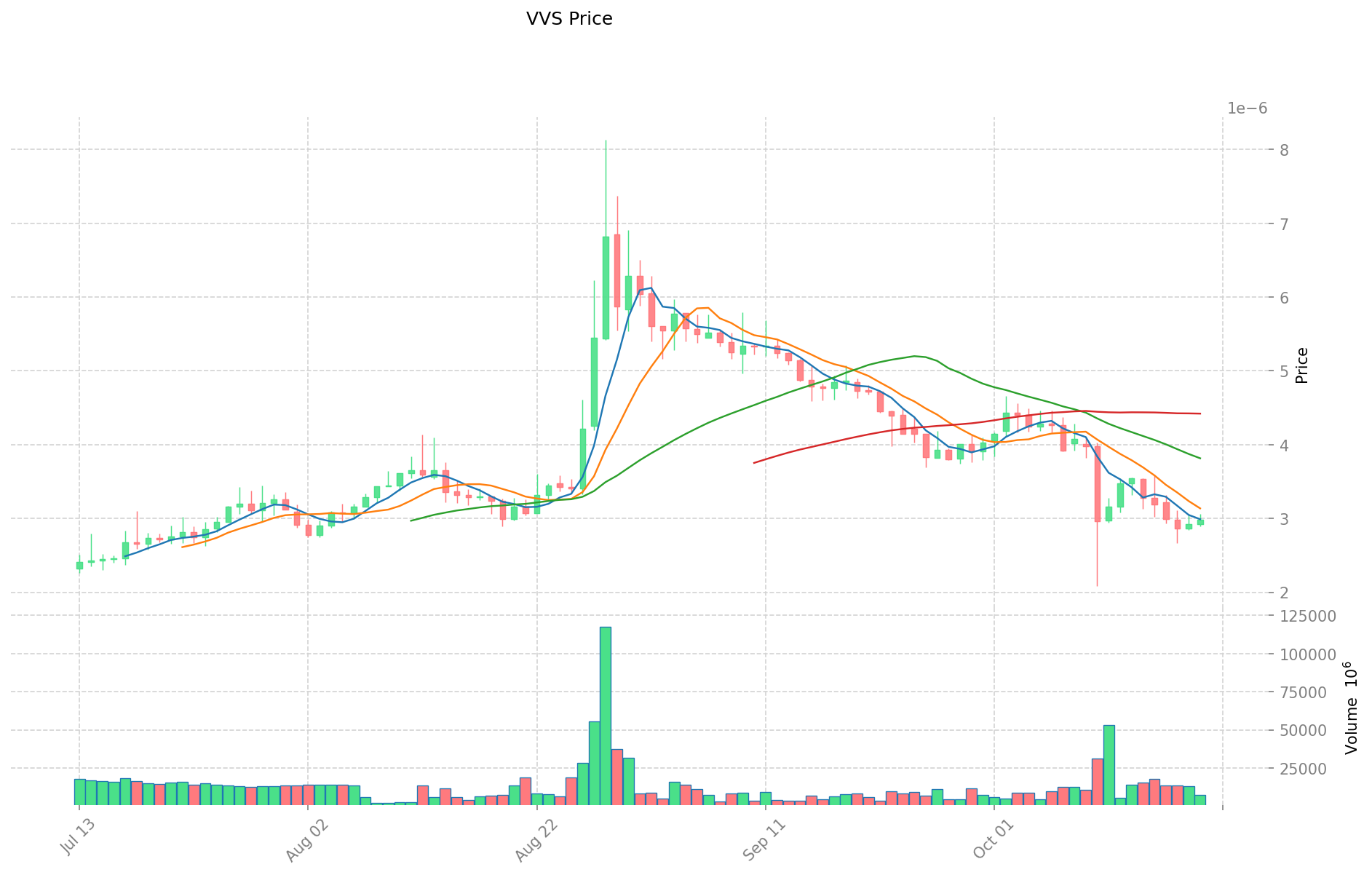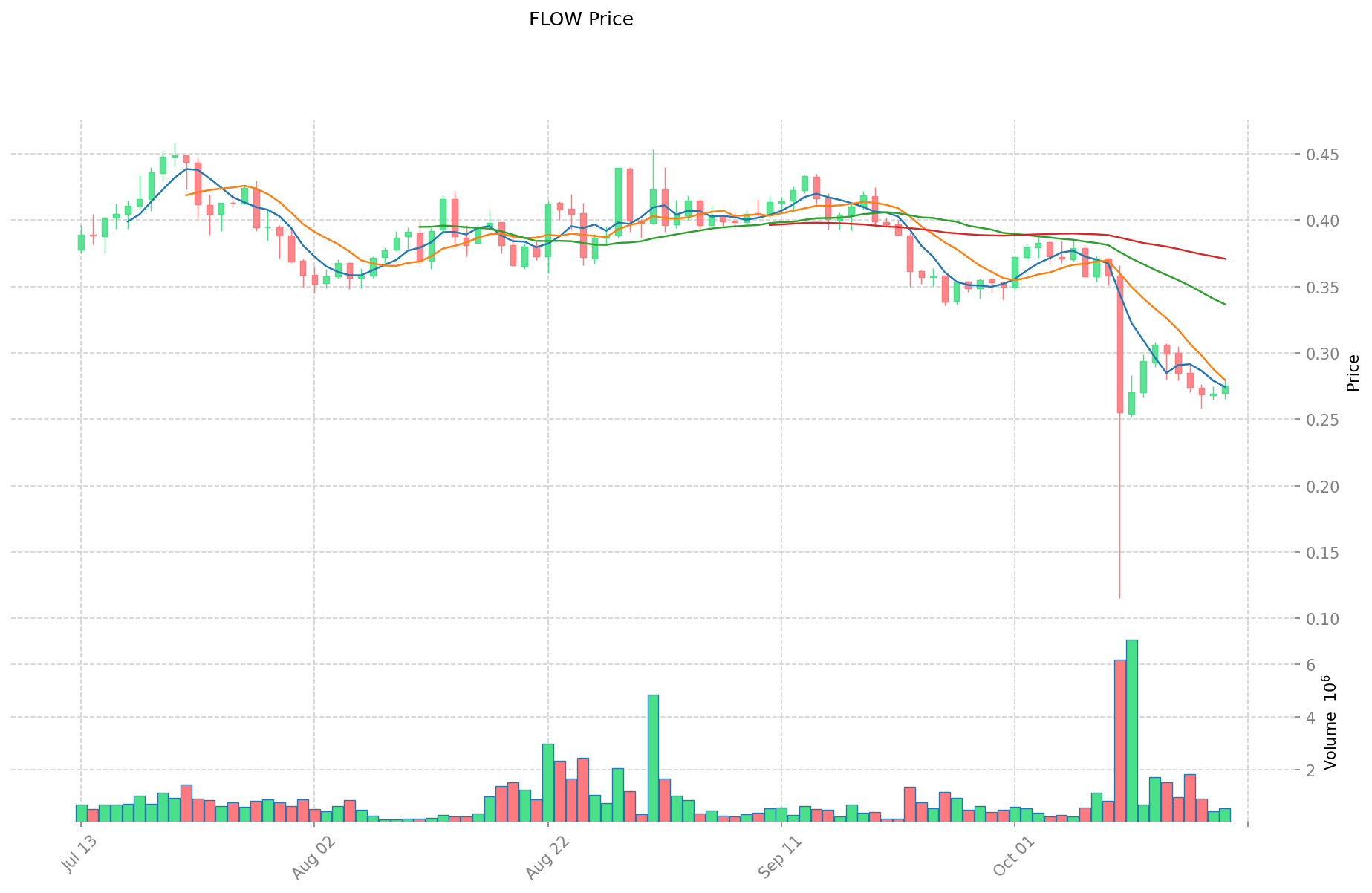VVS vs FLOW: Comparing Two Leading DeFi Protocols on Cronos Network
Introduction: VVS vs FLOW Investment Comparison
In the cryptocurrency market, the comparison between VVS and FLOW has always been a topic that investors cannot ignore. The two not only have significant differences in market cap ranking, application scenarios, and price performance, but also represent different cryptocurrency positioning.
VVS (VVS): Since its launch, it has gained market recognition as a decentralized exchange using automatic market makers (AMM) on the Cronos blockchain.
FLOW (FLOW): Since its inception, it has been hailed as a platform for next-generation games, applications, and digital assets, and is one of the cryptocurrencies with high global trading volume and market capitalization.
This article will comprehensively analyze the investment value comparison between VVS and FLOW, focusing on historical price trends, supply mechanisms, institutional adoption, technological ecosystems, and future predictions, and attempt to answer the question that investors care about most:
"Which is the better buy right now?"
I. Price History Comparison and Current Market Status
VVS (Coin A) and FLOW (Coin B) Historical Price Trends
- 2021: VVS reached its all-time high of $0.00033093 on November 15, 2021.
- 2021: FLOW hit its all-time high of $42.4 on April 5, 2021.
- Comparative analysis: Since their respective all-time highs, VVS has fallen to $0.000002987, while FLOW has dropped to $0.2753.
Current Market Situation (2025-10-20)
- VVS current price: $0.000002987
- FLOW current price: $0.2753
- 24-hour trading volume: VVS $21,023.07 vs FLOW $145,251.12
- Market Sentiment Index (Fear & Greed Index): 29 (Fear)
Click to view real-time prices:
- Check VVS current price Market Price
- Check FLOW current price Market Price
<>
基于当前供应情况,分析两种代币的通胀/通缩趋势:二、市值、流通情况及未来供应分析
市值与排名对比
流通情况
总供应量与最大供应量
通胀性分析
>


II. Key Factors Affecting the Investment Value of VVS vs FLOW
Supply Mechanism Comparison (Tokenomics)
- VVS: Inflationary tokenomics with high initial emission rate that decreases over time; designed with a maximum supply of 100 trillion tokens
- FLOW: Capped supply model with a maximum of 1.25 billion tokens, with controlled inflation that decreases over time
- 📌 Historical Pattern: Tokens with capped supply like FLOW have historically shown more price stability in the long term, while high-emission tokens like VVS typically face greater selling pressure.
Institutional Adoption and Market Applications
- Institutional Holdings: FLOW has attracted more institutional interest with backers like Andreessen Horowitz, CoinFund, and partnerships with major brands like NBA and UFC
- Enterprise Adoption: FLOW has gained traction in mainstream NFT applications including NBA Top Shot and UFC Strike, while VVS remains primarily limited to the Cronos DeFi ecosystem
- Regulatory Attitudes: Both tokens operate in uncertain regulatory environments, though FLOW's focus on NFTs and mainstream partnerships may provide better regulatory positioning
Technical Development and Ecosystem Building
- VVS Technical Development: Built on Cronos chain with AMM protocol focused on providing DeFi services like swapping and yield farming
- FLOW Technical Development: Purpose-built for NFTs and digital collectibles with a multi-node architecture designed for scalability and developer-friendly tools
- Ecosystem Comparison: VVS has a concentrated DeFi ecosystem (farms, mines, swap) while FLOW has diversified into NFTs, gaming, and entertainment applications with broader mainstream appeal
Macroeconomic Factors and Market Cycles
- Inflation Environment Performance: Neither token has demonstrated strong anti-inflationary properties, though FLOW's capped supply model theoretically offers better long-term protection
- Macroeconomic Monetary Policy: Both tokens remain highly correlated with broader crypto market movements and are influenced by Federal Reserve policies and risk appetite
- Geopolitical Factors: FLOW's mainstream partnerships may provide better insulation from geopolitical instability compared to VVS's more limited ecosystem scope
III. 2025-2030 Price Prediction: VVS vs FLOW
Short-term Prediction (2025)
- VVS: Conservative $0.0000019422 - $0.000002988 | Optimistic $0.000002988 - $0.00000436248
- FLOW: Conservative $0.140454 - $0.2754 | Optimistic $0.2754 - $0.335988
Mid-term Prediction (2027)
- VVS may enter a growth phase, with expected prices ranging from $0.000002403974484 to $0.000003993699546
- FLOW may enter a steady growth phase, with expected prices ranging from $0.2175777045 to $0.3882925188
- Key drivers: Institutional capital inflow, ETF developments, ecosystem growth
Long-term Prediction (2030)
- VVS: Base scenario $0.000005904193805 - $0.000007066063269 | Optimistic scenario $0.000007066063269 - $0.000008029703575
- FLOW: Base scenario $0.45355511863224 - $0.517052835240753 | Optimistic scenario $0.517052835240753 - $0.53836623837648
Disclaimer: These predictions are based on historical data and market analysis. Cryptocurrency markets are highly volatile and subject to change. This information should not be considered as financial advice.
VVS:
| 年份 | 预测最高价 | 预测平均价格 | 预测最低价 | 涨跌幅 |
|---|---|---|---|---|
| 2025 | 0.00000436248 | 0.000002988 | 0.0000019422 | 0 |
| 2026 | 0.0000040795164 | 0.00000367524 | 0.000003491478 | 23 |
| 2027 | 0.000003993699546 | 0.0000038773782 | 0.000002403974484 | 29 |
| 2028 | 0.00000554910981 | 0.000003935538873 | 0.000002912298766 | 31 |
| 2029 | 0.000007066063269 | 0.000004742324342 | 0.000004078398934 | 58 |
| 2030 | 0.000008029703575 | 0.000005904193805 | 0.000005727067991 | 97 |
FLOW:
| 年份 | 预测最高价 | 预测平均价格 | 预测最低价 | 涨跌幅 |
|---|---|---|---|---|
| 2025 | 0.335988 | 0.2754 | 0.140454 | 0 |
| 2026 | 0.36377586 | 0.305694 | 0.17118864 | 11 |
| 2027 | 0.3882925188 | 0.33473493 | 0.2175777045 | 21 |
| 2028 | 0.375974273376 | 0.3615137244 | 0.249444469836 | 31 |
| 2029 | 0.53836623837648 | 0.368743998888 | 0.24705847925496 | 33 |
| 2030 | 0.517052835240753 | 0.45355511863224 | 0.349237441346824 | 64 |
IV. Investment Strategy Comparison: VVS vs FLOW
Long-term vs Short-term Investment Strategy
- VVS: Suitable for investors focused on DeFi yield farming and Cronos ecosystem growth
- FLOW: Suitable for investors interested in NFTs, gaming, and mainstream adoption potential
Risk Management and Asset Allocation
- Conservative investors: VVS: 20% vs FLOW: 80%
- Aggressive investors: VVS: 40% vs FLOW: 60%
- Hedging tools: Stablecoin allocation, options, cross-token portfolio
V. Potential Risk Comparison
Market Risk
- VVS: High volatility due to inflationary tokenomics and concentrated DeFi ecosystem
- FLOW: Exposure to NFT market fluctuations and mainstream adoption challenges
Technical Risk
- VVS: Scalability issues on Cronos chain, potential smart contract vulnerabilities
- FLOW: Multi-node architecture complexity, potential security flaws in NFT implementations
Regulatory Risk
- Global regulatory policies may have different impacts on DeFi (VVS) and NFT-focused (FLOW) tokens
VI. Conclusion: Which Is the Better Buy?
📌 Investment Value Summary:
- VVS advantages: High yield potential in DeFi, strong integration with Cronos ecosystem
- FLOW advantages: Mainstream partnerships, diverse use cases in NFTs and gaming, capped supply model
✅ Investment Advice:
- New investors: Consider FLOW for its more established ecosystem and mainstream potential
- Experienced investors: Balanced approach with higher allocation to FLOW, smaller position in VVS for yield opportunities
- Institutional investors: Focus on FLOW for its institutional backing and broader market applications
⚠️ Risk Warning: The cryptocurrency market is highly volatile. This article does not constitute investment advice. None
VII. FAQ
Q1: What are the main differences between VVS and FLOW in terms of tokenomics? A: VVS has an inflationary tokenomics with a high initial emission rate that decreases over time and a maximum supply of 100 trillion tokens. FLOW, on the other hand, has a capped supply model with a maximum of 1.25 billion tokens and controlled inflation that decreases over time.
Q2: Which token has shown better institutional adoption? A: FLOW has attracted more institutional interest with backers like Andreessen Horowitz and CoinFund, as well as partnerships with major brands like NBA and UFC. VVS remains primarily limited to the Cronos DeFi ecosystem.
Q3: How do the ecosystems of VVS and FLOW compare? A: VVS has a concentrated DeFi ecosystem focusing on farms, mines, and swaps. FLOW has diversified into NFTs, gaming, and entertainment applications with broader mainstream appeal.
Q4: What are the price predictions for VVS and FLOW in 2030? A: For VVS, the base scenario predicts $0.000005904193805 - $0.000007066063269, with an optimistic scenario of $0.000007066063269 - $0.000008029703575. For FLOW, the base scenario predicts $0.45355511863224 - $0.517052835240753, with an optimistic scenario of $0.517052835240753 - $0.53836623837648.
Q5: How should investors allocate their portfolio between VVS and FLOW? A: Conservative investors might consider allocating 20% to VVS and 80% to FLOW, while aggressive investors might opt for 40% VVS and 60% FLOW.
Q6: What are the main risks associated with investing in VVS and FLOW? A: VVS faces high volatility due to inflationary tokenomics and a concentrated DeFi ecosystem. FLOW is exposed to NFT market fluctuations and mainstream adoption challenges. Both face potential technical and regulatory risks.
Share
Content